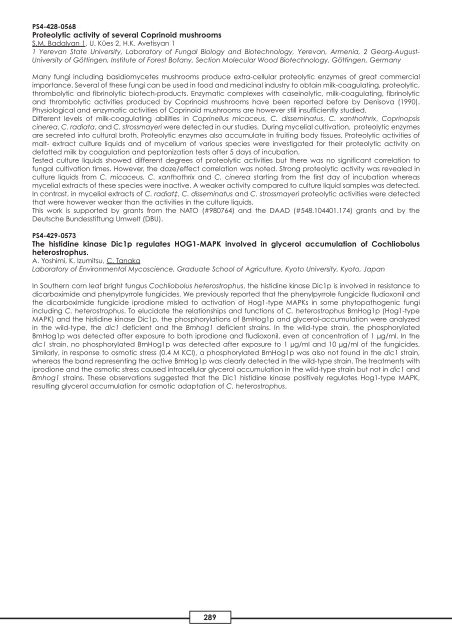Handbook Part 2 - International Mycological Association
Handbook Part 2 - International Mycological Association
Handbook Part 2 - International Mycological Association
You also want an ePaper? Increase the reach of your titles
YUMPU automatically turns print PDFs into web optimized ePapers that Google loves.
PS4-428-0568<br />
Proteolytic activity of several Coprinoid mushrooms<br />
S.M. Badalyan 1, U. Kües 2, H.K. Avetisyan 1<br />
1 Yerevan State University, Laboratory of Fungal Biology and Biotechnology, Yerevan, Armenia, 2 Georg-August-<br />
University of Göttingen, Institute of Forest Botany, Section Molecular Wood Biotechnology, Göttingen, Germany<br />
Many fungi including basidiomycetes mushrooms produce extra-cellular proteolytic enzymes of great commercial<br />
importance. Several of these fungi can be used in food and medicinal industry to obtain milk-coagulating, proteolytic,<br />
thrombolytic and fibrinolytic biotech-products. Enzymatic complexes with caseinolytic, milk-coagulating, fibrinolytic<br />
and thrombolytic activities produced by Coprinoid mushrooms have been reported before by Denisova (1990).<br />
Physiological and enzymatic activities of Coprinoid mushrooms are however still insufficiently studied.<br />
Different levels of milk-coagulating abilities in Coprinellus micaceus, C. disseminatus, C. xanthothrix, Coprinopsis<br />
cinerea, C. radiata, and C. strossmayeri were detected in our studies. During mycelial cultivation, proteolytic enzymes<br />
are secreted into cultural broth. Proteolytic enzymes also accumulate in fruiting body tissues. Proteolytic activities of<br />
malt- extract culture liquids and of mycelium of various species were investigated for their proteolytic activity on<br />
defatted milk by coagulation and peptonization tests after 5 days of incubation.<br />
Tested culture liquids showed different degrees of proteolytic activities but there was no significant correlation to<br />
fungal cultivation times. However, the doze/effect correlation was noted. Strong proteolytic activity was revealed in<br />
culture liquids from C. micaceus, C. xanthothrix and C. cinerea starting from the first day of incubation whereas<br />
mycelial extracts of these species were inactive. A weaker activity compared to culture liquid samples was detected.<br />
In contrast, in mycelial extracts of C. radiat‡, C. disseminatus and C. strossmayeri proteolytic activities were detected<br />
that were however weaker than the activities in the culture liquids.<br />
This work is supported by grants from the NATO (#980764) and the DAAD (#548.104401.174) grants and by the<br />
Deutsche Bundesstiftung Umwelt (DBU).<br />
PS4-429-0573<br />
The histidine kinase Dic1p regulates HOG1-MAPK involved in glycerol accumulation of Cochliobolus<br />
heterostrophus.<br />
A. Yoshimi, K. Izumitsu, C. Tanaka<br />
Laboratory of Environmental Mycoscience, Graduate School of Agriculture, Kyoto University, Kyoto, Japan<br />
In Southern corn leaf bright fungus Cochliobolus heterostrophus, the histidine kinase Dic1p is involved in resistance to<br />
dicarboximide and phenylpyrrole fungicides. We previously reported that the phenylpyrrole fungicide fludioxonil and<br />
the dicarboximide fungicide iprodione misled to activation of Hog1-type MAPKs in some phytopathogenic fungi<br />
including C. heterostrophus. To elucidate the relationships and functions of C. heterostrophus BmHog1p (Hog1-type<br />
MAPK) and the histidine kinase Dic1p, the phosphorylations of BmHog1p and glycerol-accumulation were analyzed<br />
in the wild-type, the dic1 deficient and the Bmhog1 deficient strains. In the wild-type strain, the phosphorylated<br />
BmHog1p was detected after exposure to both iprodione and fludioxonil, even at concentration of 1 µg/ml. In the<br />
dic1 strain, no phosphorylated BmHog1p was detected after exposure to 1 µg/ml and 10 µg/ml of the fungicides.<br />
Similarly, in response to osmotic stress (0.4 M KCl), a phosphorylated BmHog1p was also not found in the dic1 strain,<br />
whereas the band representing the active BmHog1p was clearly detected in the wild-type strain. The treatments with<br />
iprodione and the osmotic stress caused intracellular glycerol accumulation in the wild-type strain but not in dic1 and<br />
Bmhog1 strains. These observations suggested that the Dic1 histidine kinase positively regulates Hog1-type MAPK,<br />
resulting glycerol accumulation for osmotic adaptation of C. heterostrophus.<br />
289









